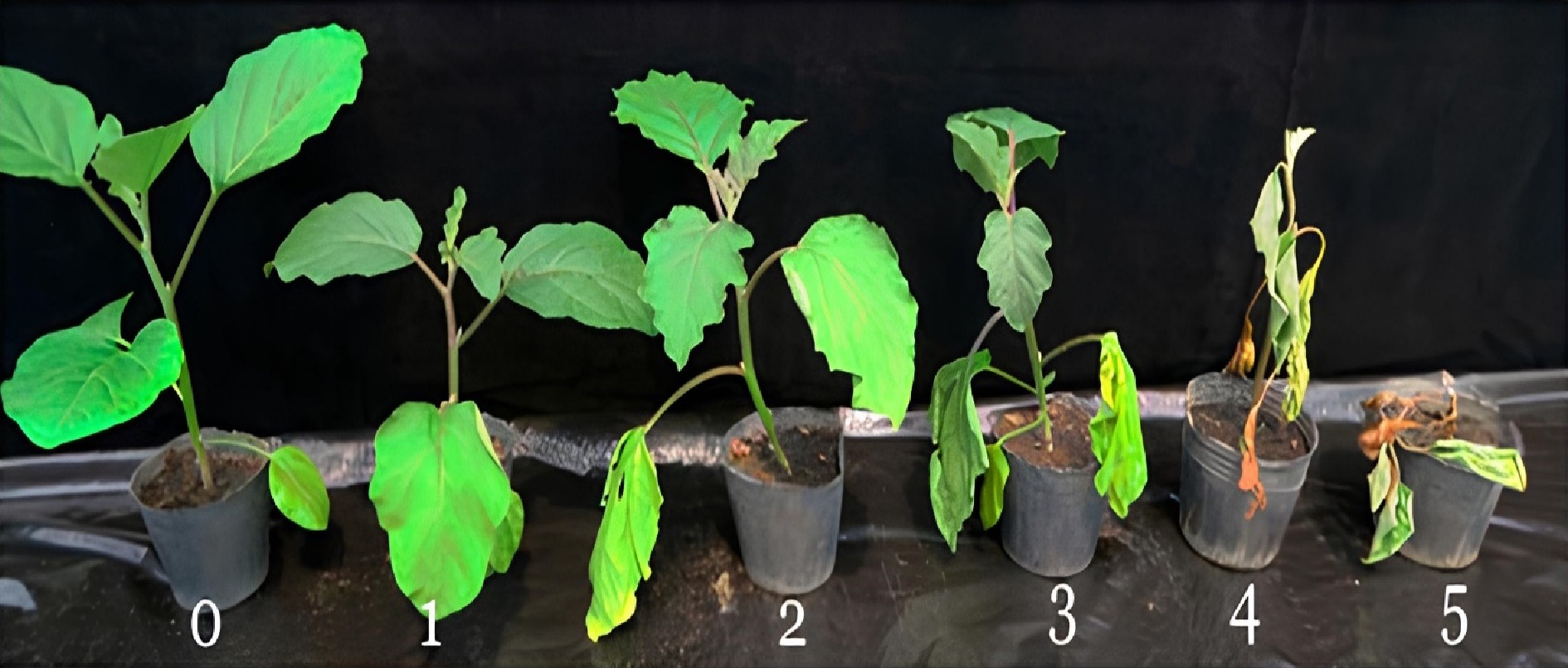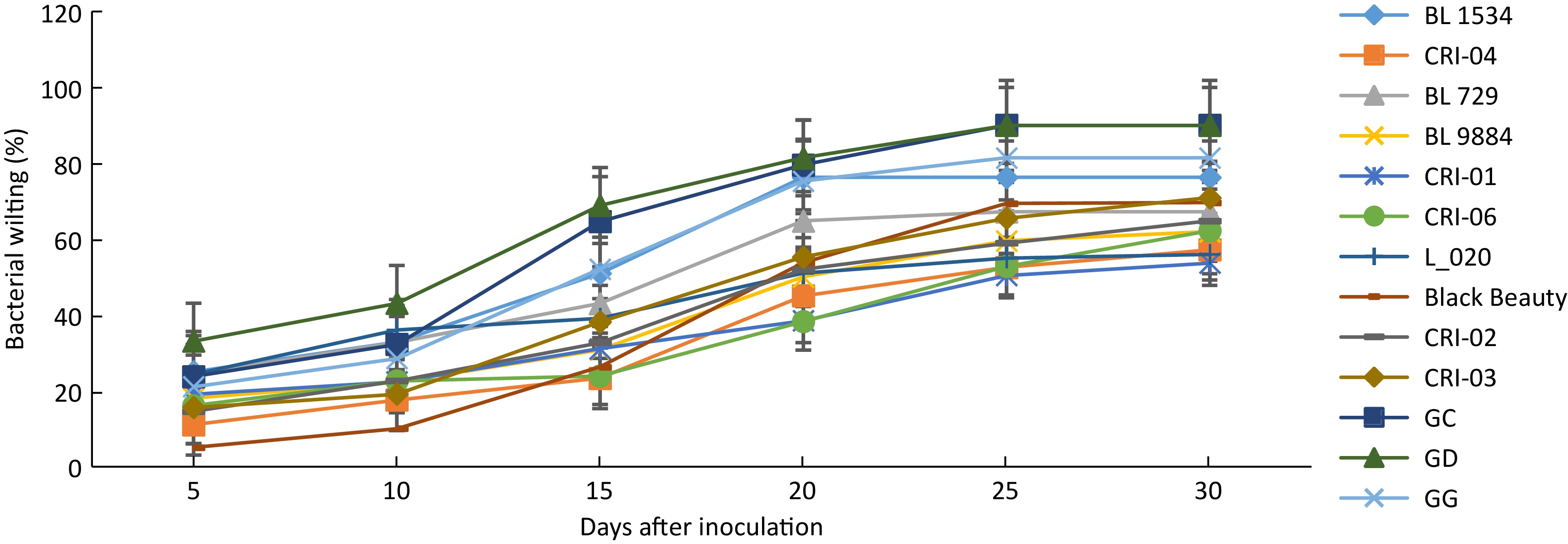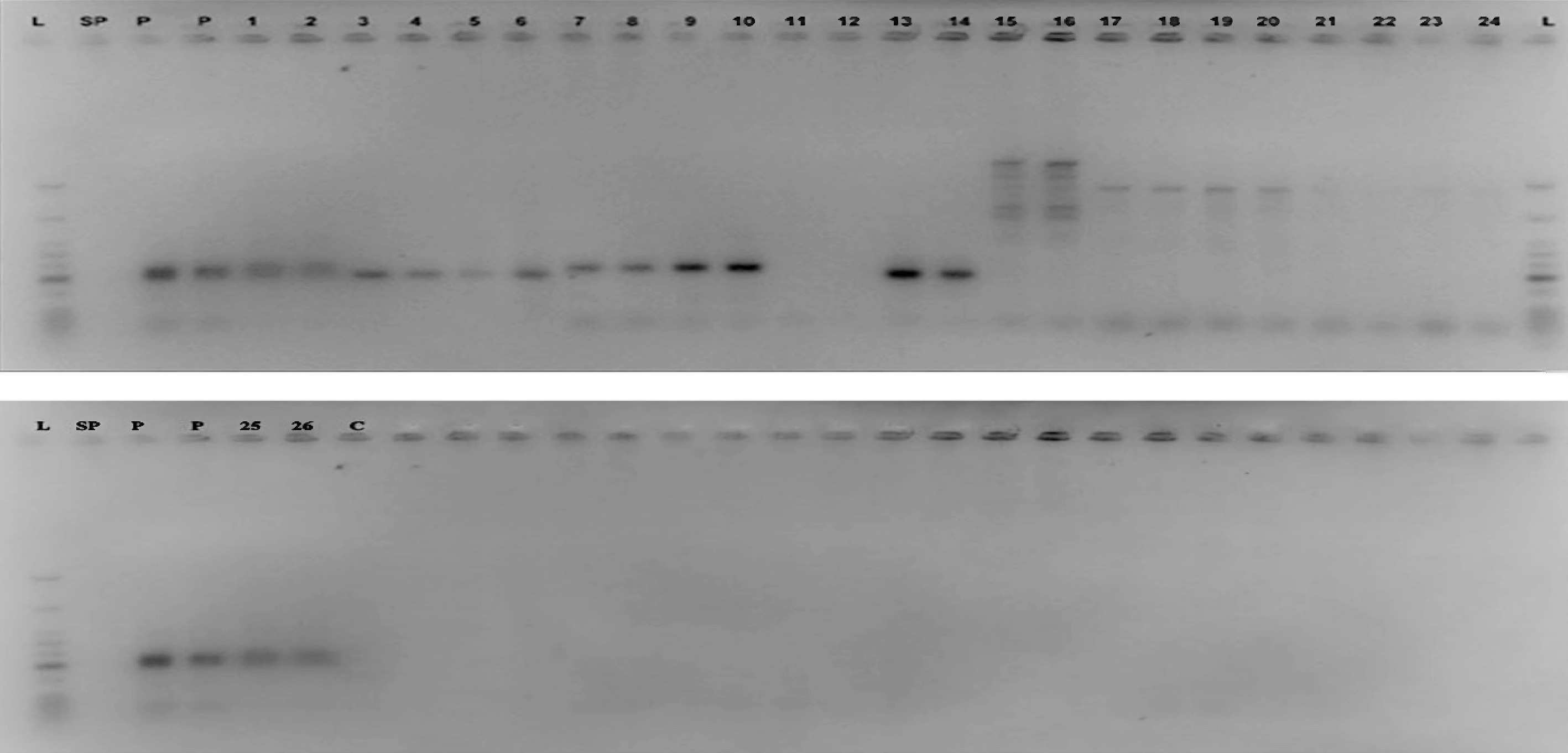-

Figure 1.
Bacterial wilt disease rating scale (0 = no symptoms, 1 = only one leaf partially wilted, 2 = two or three leaves wilted, 3 = all leaves except two or three wilted, 4 = all leaves wilted, 5 = dead plant).
-

Figure 2.
Wilting incidence among 13 solanum accessions. Error bars represent the standard error of the treatment means.
-

Figure 3.
Agarose gel image of the marker SLM 12-2 for the detection of the Bwr-12 gene L = Molecular weight ladder; SP = Space; P = Positive control; Well 1 & 2 = L_020; 3 & 4 = BL1534; 5 & 6 = BL729; 7 & 8 = GG; 9 & 10 = GC; 11 & 12 = GD; 13 & 14 = BL9884; 15 & 16 = Black Beauty; 17 & 18 = CRI 01; 19 & 20 = CRI 02; 21 & 22 = CRI 03; 23 & 24 = CRI 04; 25 & 26 = CRI 06; C = Negative control.
-
No. Code Solanum spp. Biological status Source Country/Region of origin 1 BL 729 Tomato Breeding line Worldveg Taiwan 2 BL 9884 Tomato Breeding line Worldveg Taiwan 3 L_020 Tomato Open pollinated TGRC, UC Davis USA 4 GC Tomato Open-pollinated TGRC, UC Davis USA 5 BL 1534 Tomato Breeding line Worldveg Taiwan 6 GD Tomato Open pollinated TGRC, UC Davis USA 7 GG Tomato Open pollinated TGRC, UC Davis USA 8 CRI-06 Garden eggs Breeding line CSIR-CRI Ghana 9 CRI-04 Garden eggs Breeding line CSIR-CRI Ghana 10 CRI-03 Garden eggs Breeding line CSIR-CRI Ghana 11 CRI-02 Garden eggs Breeding line CSIR-CRI Ghana 12 CRI-01 Garden eggs Breeding line CSIR-CRI Ghana 13 Black Beauty Garden eggs Open pollinated CSIR-CRI Ghana Table 1.
List of tomato and garden egg accessions evaluated in the study.
-
DI score (0−1) Reaction 0.00−0.20 Highly resistant 0.21−0.30 Resistant 0.31−0.40 Moderately resistant 0.41−0.50 Moderately susceptible 0.51−0.60 Susceptible 0.61−0.90 Highly susceptible 0.91−1.00 Extremely susceptible Table 2.
Scale based on disease index for the classification of solanum germplasm.[2]
-
Trait Primer R-gene Forward primer (5'-3') Reverse primer (3'-5') Annealing temperature (°C) Product size (bp) Ref. Resistant genotype Susceptible genotype Bacteria wilt resistance SLM12–2 Bwr-12 ATCTCATTCAACGCACACCA AACGGTGGAAACTATTG
AAAGG55 209 No reference band [12] SLM12–10 Bwr-12 ACCGCCCTAGCCATAAAGAC TGCGTCGAAAATAGTTGCAT 242 SLM6–124 Bwr-6 CATGGGTTAGCAGATGATT
CAAGCTAGGTTATTGGGCCAGAA 292 SLM6–118 Bwr-6 TCCCAAAGTGCAATAGG
ACACACATAACATGGAGTTCGACAGA 183 SLM6–119 Bwr-6 GCCTGCCCTACAACAAC
ATTCGACATCAAACCTATGAC
TGGA255 SLM6–136 Bwr-6 CCAGGCCACATAGAACTC
AAGACAGGTCTCCATACGGCATC 290 SLM6–17 Bwr-6 TCCTTCAAATCTCCCA
TCAAACGAGCAATTGCAAGG
AAAA186 SLM6–94 Bwr-6 CTAAATTTAAATGGACAA
GTAATAGCCCACGATAGGTTGGTATTTTCTGG 276 Table 3.
Sequences and expected product size of primers used for the study.
-
Accession Mean disease
severity index (0–1)Host reaction CRI-06 0.45 Moderately susceptible CRI-03 0.56 Susceptible CRI-04 0.37 Moderately resistant CRI-02 0.47 Moderately susceptible CRI-01 0.52 Susceptible Black Beauty 0.61 Susceptible p < 0.05 NS Table 4.
Mean bacterial wilt disease severity among garden egg accessions evaluated.
-
Accession Disease severity index (0–1) Host reaction BL 729 0.53ab Susceptible BL 9884 0.44b Moderately susceptible GG 0.71ab Highly susceptible L_020 0.39b Moderately resistant GC 0.90a Highly susceptible BL 1534 0.70ab Highly susceptible GD 0.70ab Highly susceptible Means followed by different letters are significantly different. Table 5.
Bacterial wilt disease severity and host reaction status among tomato accessions evaluated.
-
Genotypes SSR markers Disease reaction Bwr-12 Bwr-6 SLM 12-2 SLM 12-10 SLM 6-136 SLM 6-119 SLM 6-94 SLM 6-118 SLM 6-110 SLM 6-124 SLM 6-17 L_020 +/+ +/+ +/+ +/+ +/+ −/− −/− −/− −/− Durable resistance BL1534 −/− −/− +/+ −/− −/− +/+ −/− −/− −/− Partial resistance BL729 −/− −/− −/− +/+ +/+ +/+ +/+ +/+ +/+ Partial resistance GG +/+ +/+ +/+ +/+ −/− +/+ +/+ +/+ −/− Durable resistance GC +/+ +/+ +/+ −/− +/+ −/− +/+ +/+ −/− Durable resistance GD −/− −/− −/− −/− −/− −/− −/− −/− +/+ Partial resistance BL9884 −/− −/− +/+ +/+ −/− +/+ −/− +/+ −/− Partial resistance Black Beauty −/− −/− −/− +/+ +/+ +/+ +/+ +/+ −/− Partial resistance CRI 01 −/− −/− −/− −/− −/− +/+ −/− −/− −/− Partial resistance CRI 02 −/− −/− +/+ −/− −/− +/+ −/− −/− −/− Partial resistance CRI 03 −/− −/− +/+ −/− −/− +/+ −/− −/− −/− Partial resistance CRI 04 −/− −/− −/− −/− −/− −/− −/− −/− −/− Partial resistance CRI 06 −/− −/− −/− −/− −/− −/− +/+ −/− −/− Partial resistance Table 6.
Scores for bacteria wilt resistant gene(s) in tomato and garden egg genotypes.
Figures
(3)
Tables
(6)